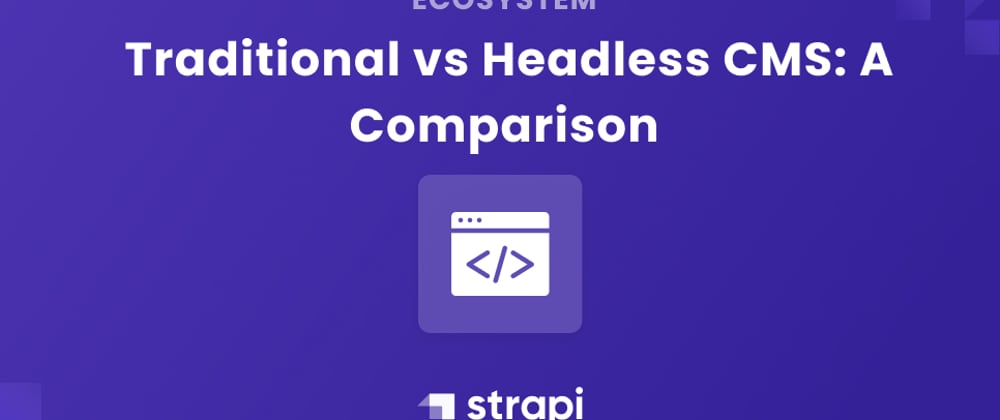There are different types of content management systems. In this article, we will focus on comparing traditional and headless CMSs to showcase why moving to a headless CMS can be an advantage to you.
What is a Content Management System?
A content management system is a software application that helps users create, manage, edit, store and publish digital content on a website. CMSs help users build websites and launch products without having to write code.
What is a Headless CMS?
A headless CMS is a content management system where the frontend and backend are separated from each other. With headless CMSs, the stored content is made available to developers through APIs.
Headless CMSs are frontend agnostic and API-driven by design. This way, developers are free to deliver the content to their audience with the frameworks and technologies of their choice.
What is a Traditional CMS?
A traditional CMS is a monolithic content delivery system. With a traditional CMS, the frontend and backend are coupled together.
Though headless CMSs are gaining popularity as the go-to solution for content delivery, traditional CMSs are still the most popular. As of this writing, WordPress holds the largest CMS market share of 36%.
Traditional vs. Headless CMSs: Why should you use a headless CMS?
While both CMS architectures have different benefits, here’s a comparison that highlights the difference between both CMSs and the ten benefits you gain when choosing a headless CMS.
- Omnichannel freedom
With Headless CMSs, you have the freedom to decide where and how your content is delivered. Headless CMSs are frontend agnostic by design. They have no opinion of how the content is displayed. This means you can adapt your content for omnichannel delivery anywhere, such as websites, mobile phones, smartwatches, AR/VR, even jumbotrons. With headless CMS, the channels of content delivery are limitless.
With traditional CMSs, however, you do not have omnichannel freedom. You are constrained and limited to delivering your content to the channels the CMS supports. This means if you intend to deliver your content to mobile phones and the CMS doesn't support that channel, you would be unable to do so.
- Developer Benefits
With traditional CMSs, developers are restricted to building applications and websites in line with the CMS's architecture, and the tools and technologies they support. This results in slower, less flexible customizations. Developers are often stuck having to learn how to use vendor-specific, decades-old frameworks. Headless CMSs give developers the ability to work with the best tools to do the best work. By utilizing APIs and data formats like JSON to communicate and pull content, they can use the latest Jamstack technologies or the tech stack of their choice.
With traditional CMSs, switching from one vendor to another is costly and time-consuming because developers will have to learn the programming languages compatible with each new CMS. However, headless CMSs don't have this drawback, being API-based. You can decide to switch from one headless CMS to another without incurring any technical debt, loss of time, or resources.
- Scalability
Traditional CMS systems usually host the content in-house, making it harder to handle traffic and scale because of limited servers. Also, any server downtime affects both the frontend and backend since they are coupled together.
With the frontend separated from the backend, if the CMS should go offline, have issues, or need maintenance, there will be no downtime on the frontend application.
Headless CMSs protect you from everything – from unforeseen traffic spikes to loss of data. Should an event occur, your data is stored safely in the cloud. This means you can quickly go live thanks to the reliable digital backup.
- Faster Editing
Being content-focused, headless CMS enables marketers and content editors to work without distractions. They provide a user interface that makes uploading, editing, searching, structuring, and managing content easy. Headless CMSs provide a simplistic and distraction-free experience for content teams.
With traditional CMSs, content editing is not a seamless experience because the content, frontend, and codes are in the same system. This can distract from editing and make for a poor editing experience.
Another benefit for editors is that if they decide to adopt a new content delivery channel, they would not have to re-author the content to fit that channel. This avoids duplication of content and makes content easier to manage as you expand to new channels.
Having the frontend and backend separated allows editors to create and edit content without worrying about the frontend presentation and delivery. Also, they do not need to wait until developers are done coding to complete their work.
- Security
Headless CMSs are less vulnerable to DDoS attacks since the frontend is separated from the backend. Headless CMSs have only one access point, their APIs, so the surface area of security attacks is smaller. This means that there are fewer security concerns when choosing a headless CMS.
Unlike headless CMSs, traditional CMSs are database-driven and are more vulnerable to DDoS and other security attacks.
Also, traditional CMSs require frequent security upgrades with every new security patch that gets released. Therefore, websites built on traditional CMSs are more prone to getting hacked, usually through insecure plugins or the sites not being updated regularly.
- Future Proof Content
Traditional CMSs have a single content delivery channel in mind – websites. In the decades since traditional CMSs were built, several new channels like AR, VR, and smartwatch devices have come up. Traditional CMS limits you from being able to reach your audience where they are.
With headless CMSs, there are no boundaries to the number of digital experiences you can create with your content and the channels you can reach. As new technologies emerge, headless CMSs allow you to create new digital experiences to interact with your audience and stay relevant.
The API-driven approach enables you to come up with more innovative ways of delivering your content.
Headless CMS doesn't only enable you to reach your customers of today, but they evolve with technologies so you can reach your customers in whatsoever device they use in the future.
- No-bloat Systems
Traditional CMSs come with several forms of customizations in an attempt to help solve your content delivery problems. The problem with this is that there are too many extra features that come pre-packed with the CMS.
Not only that, but you often have to work with legacy software, and that can become detrimental and disruptive to your product development.
With headless CMSs, you don't have to deal with bloated systems or legacy software. You decide the tools you want to integrate into your products. Headless CMSs are less disruptive to development. If anything, they boost the productivity of your team.
- Faster time-to-market
Being API-driven, headless CMSs make it easier for you to integrate, manipulate, and distribute your content. Since the content is not bound to the frontend, you can target new channels without changing the backend. This cross-platform support increases optimization and decreases time-to-market significantly.
Adapting content to fit new channels will take more time using a traditional CMS. For every new channel you want to deliver your content to, you would have to not only build a frontend, but also reauthor your content for that channel. Not only is this an unnecessary duplication and ineffective way to work, but it also increases the chances of your content falling out of sync across channels.
- Automatic Updates
With traditional CMSs, you are responsible for keeping things like plugins, themes, and software updated. Not only that, but you also have to test the updates to ensure they are compatible with other plugins and themes. There are situations where updates break plugins, and to avoid that, and you would have to create a backup before updating. Having to do this regularly to keep your CMS up to date becomes expensive and time-consuming.
With headless CMSs, you do not have to worry about keeping plugins, themes, or system software updated. The headless vendors keep their systems updated, enabling you to focus and work without distractions.
- Performance
A slow website is bad for businesses. It leads to loss of traffic, poor customer experience, poor SEO rankings, and loss of sales. Headless CMSs help keep your website performant.
Being API-driven, you can opt-in for performant page rendering methods like Server-Side Rendering, SSR, and Static Site Generation, SSG.
With headless CMSs, you can leverage the latest tools, libraries, and frameworks in web technologies and use them to boost the speed of your website.
Traditional CMSs come packed with plugins that affect the speed and performance of websites. The more plugins you add, the less performant your website becomes because the plugins add code that runs every time a user visits a page.
Conclusion
We have looked at why you should consider using a headless CMS, and how they solve the problems of managing content for businesses and brands. With a headless CMS, you are positioned for exponential growth, speed, and productivity.







Top comments (0)